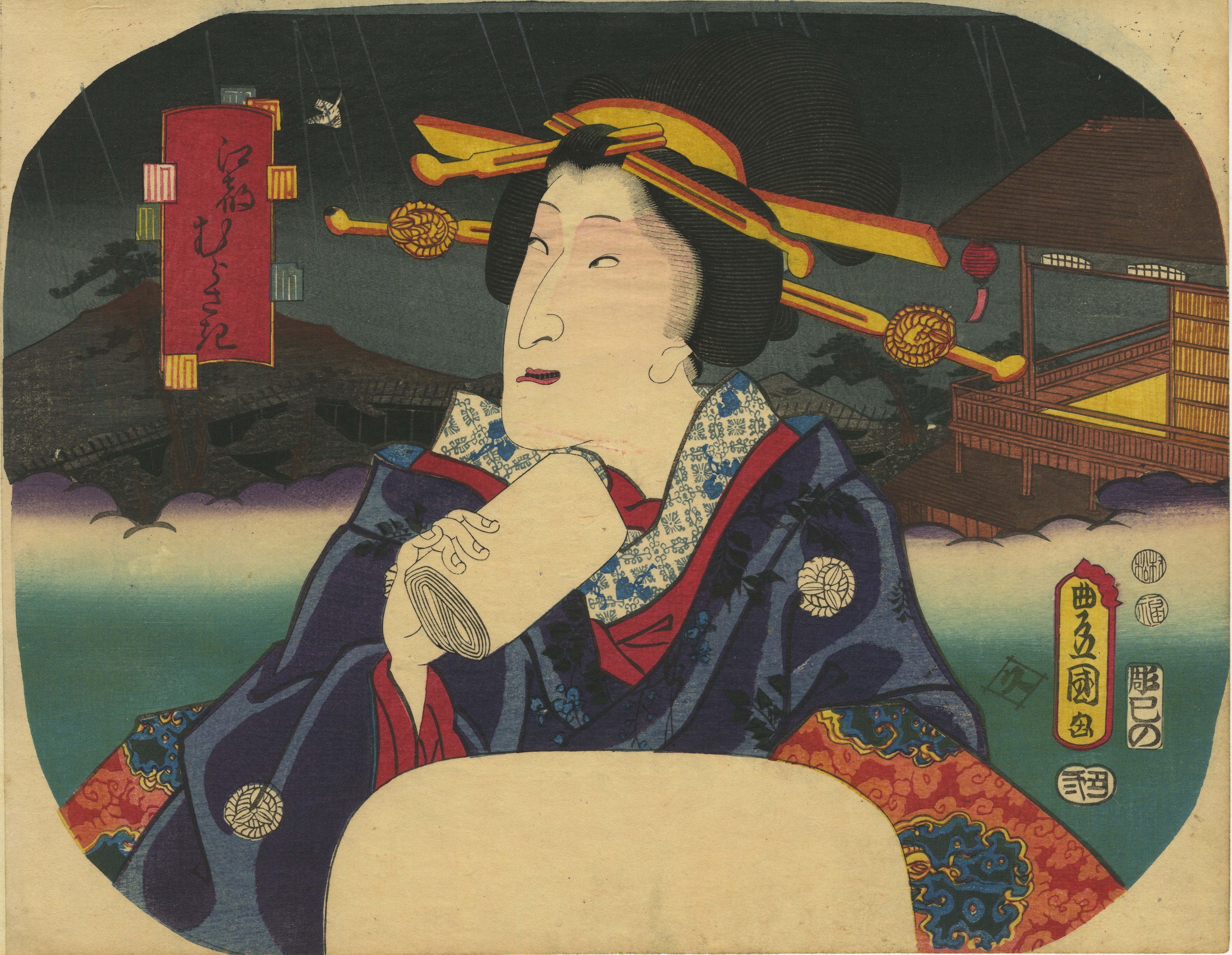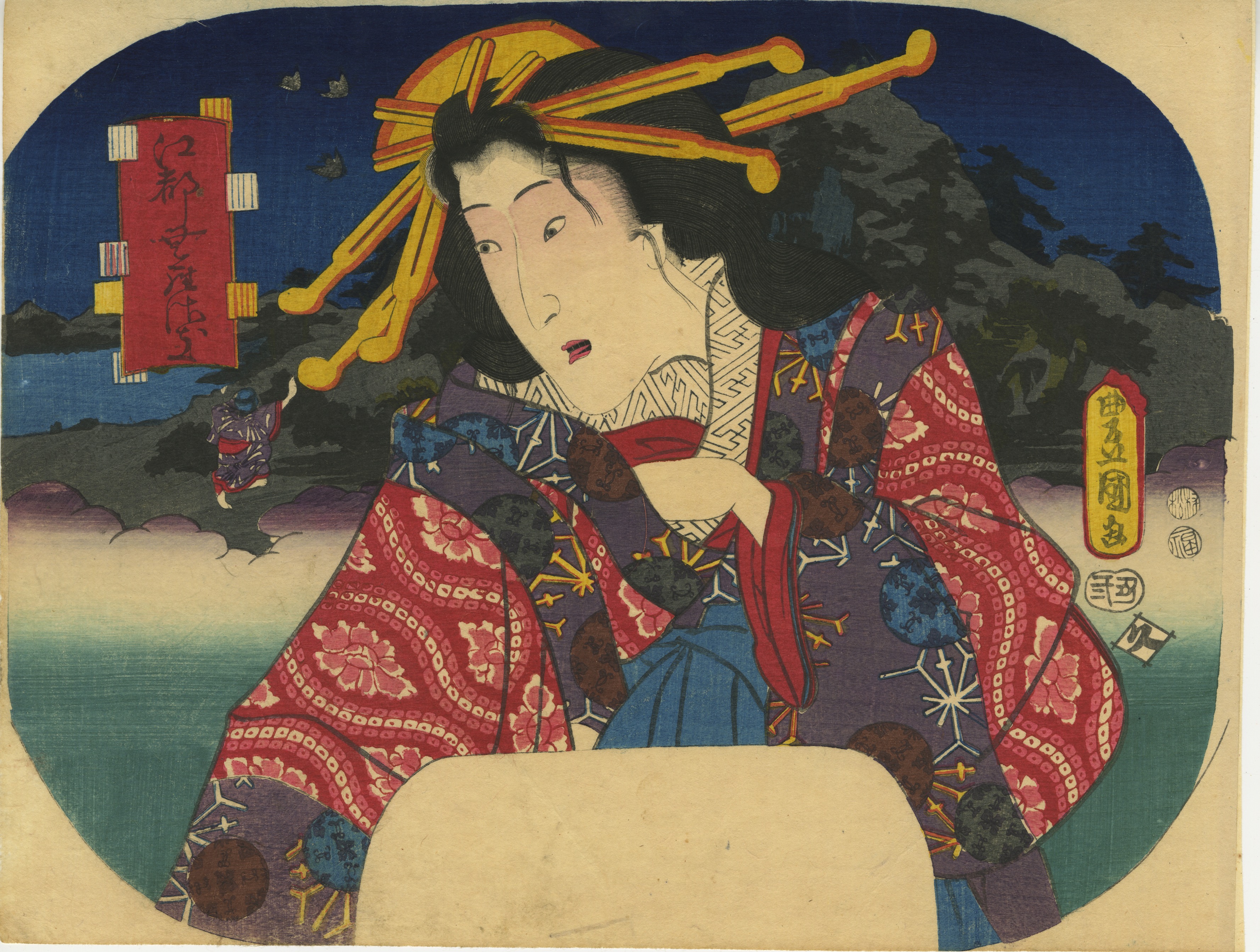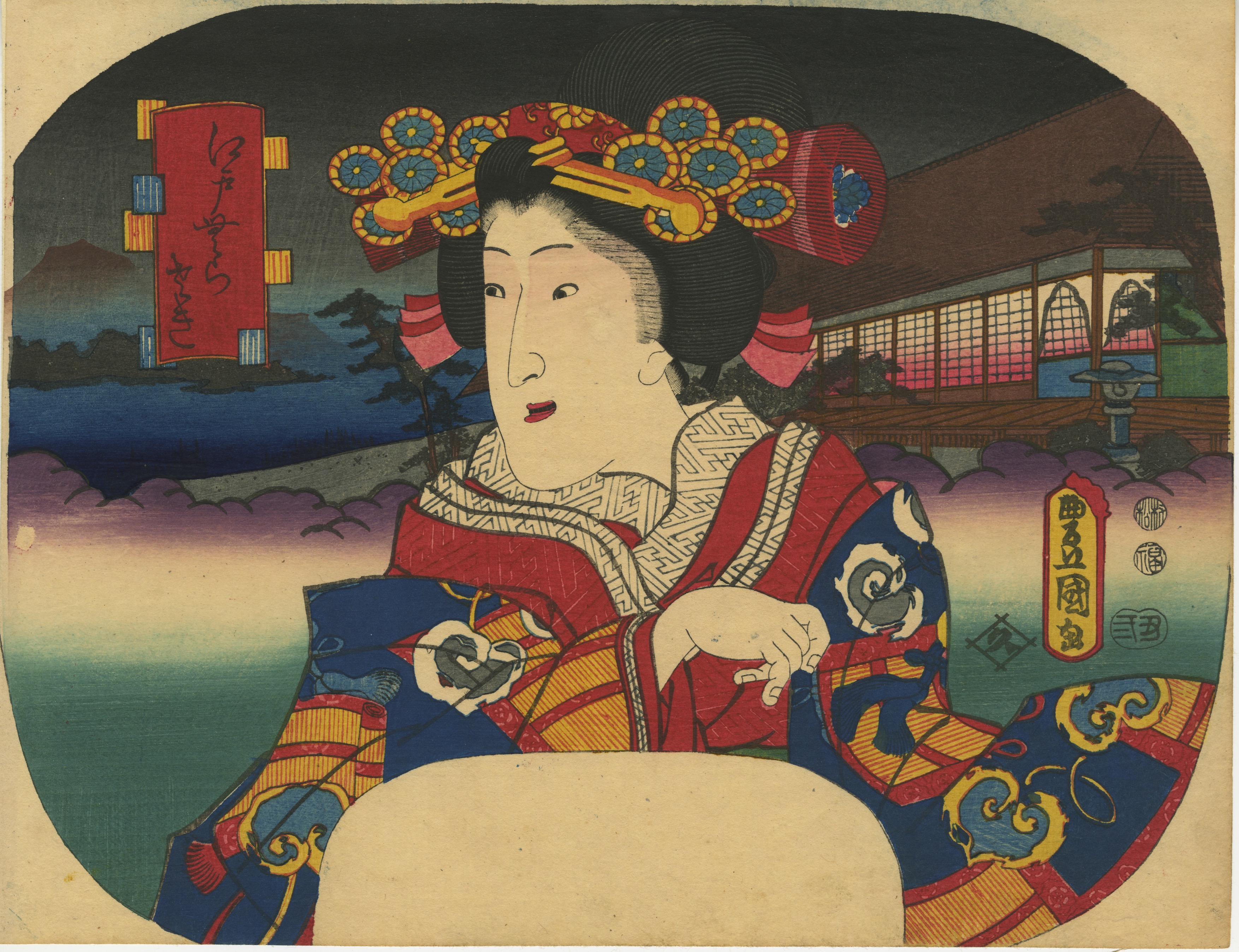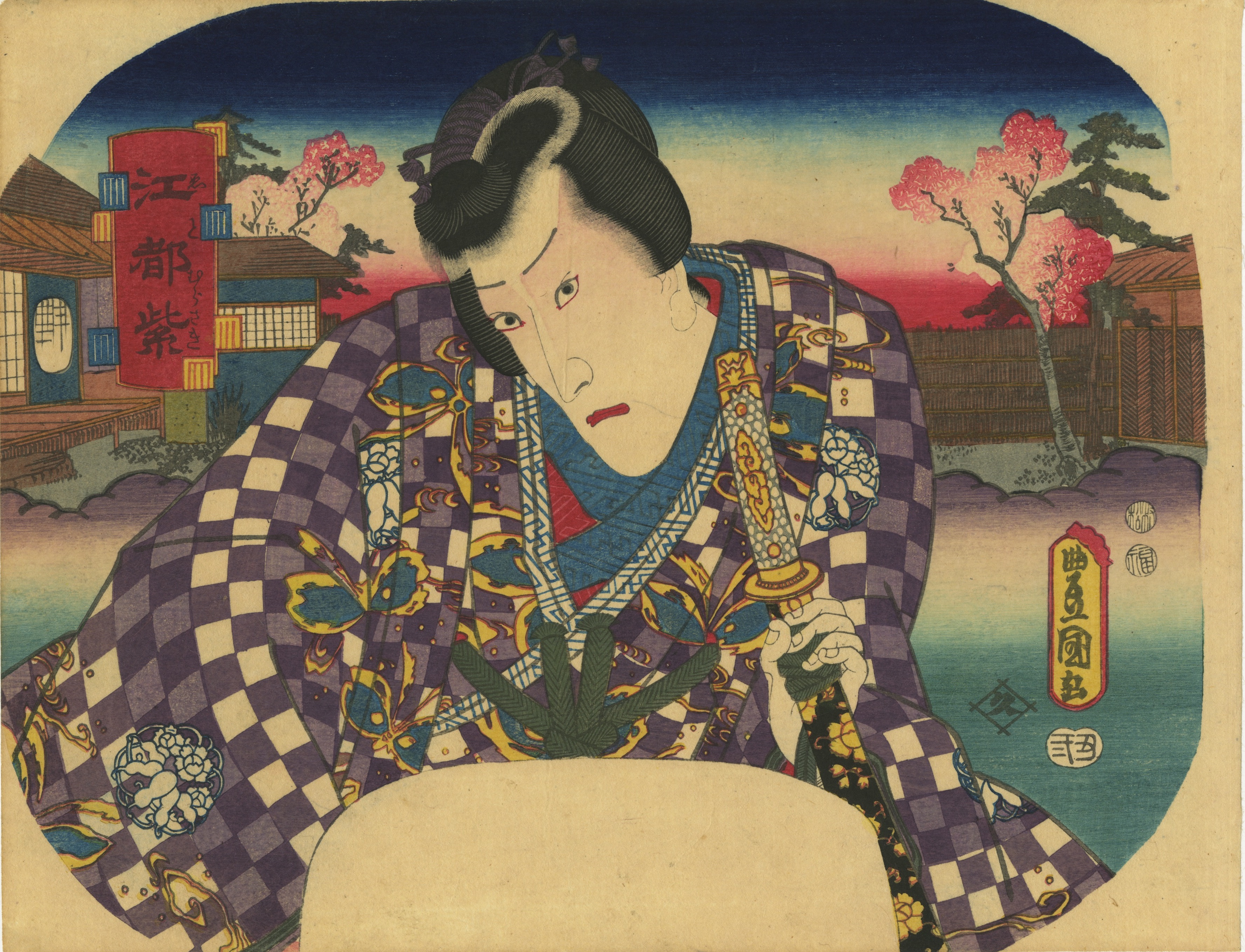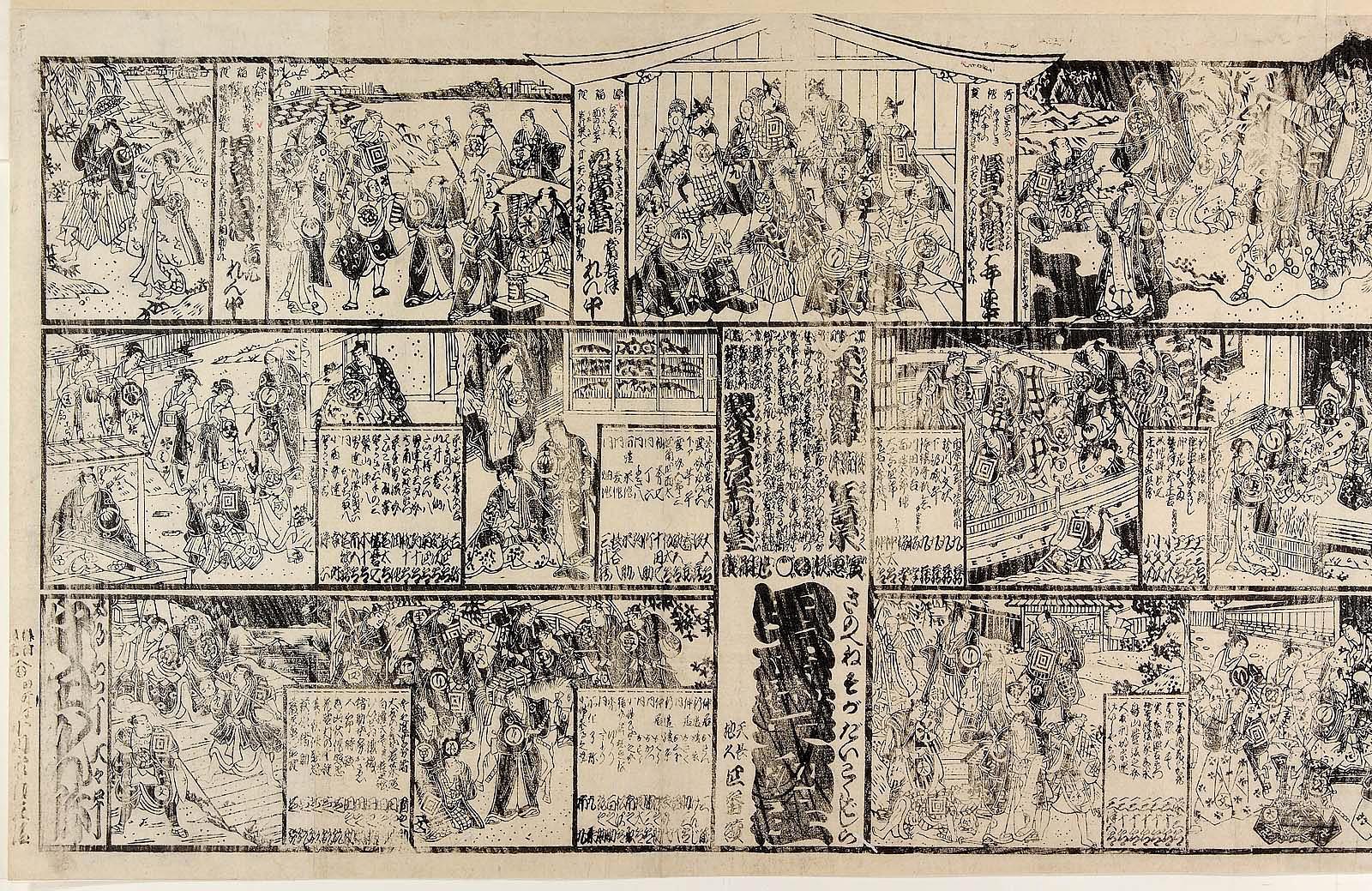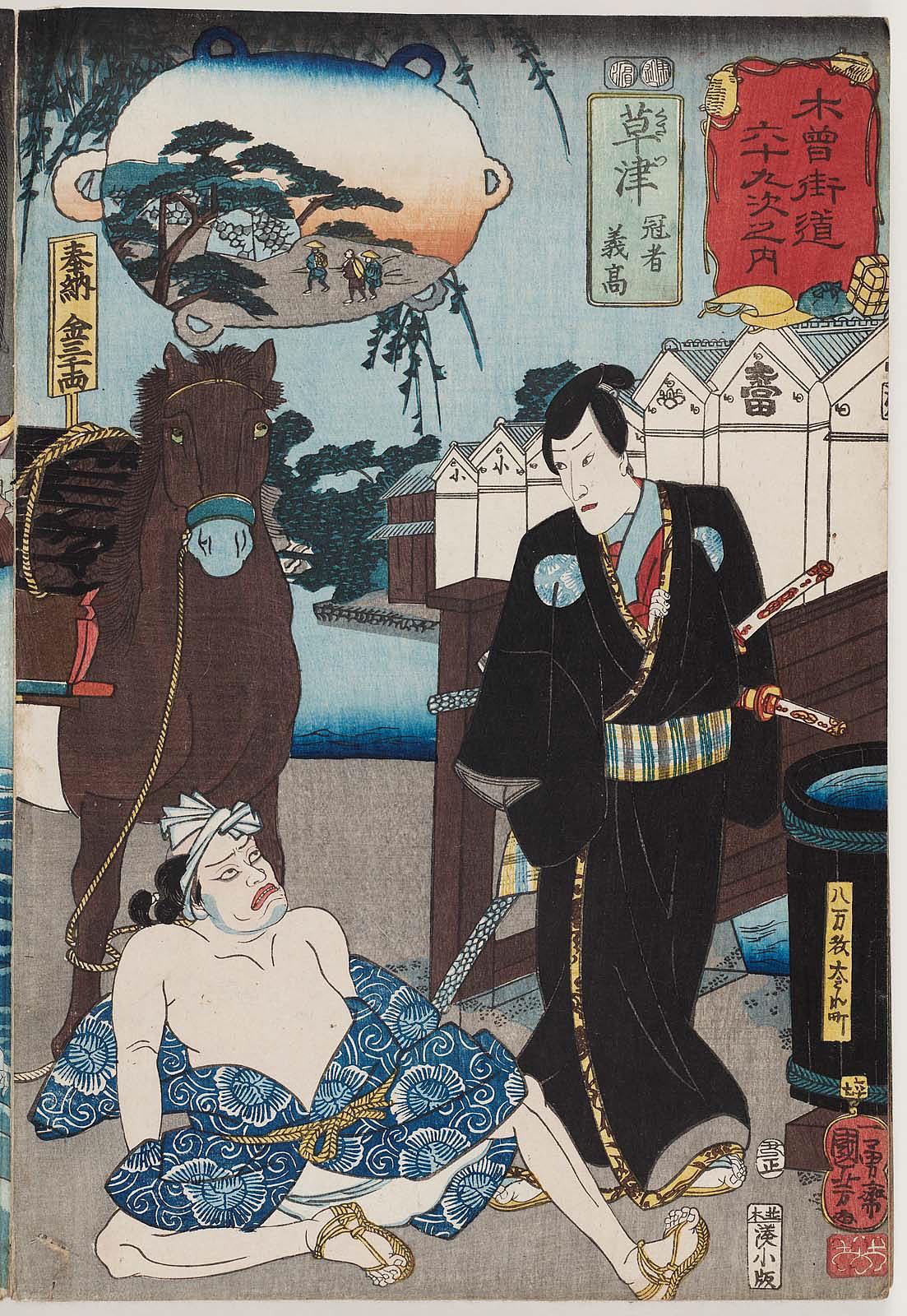-
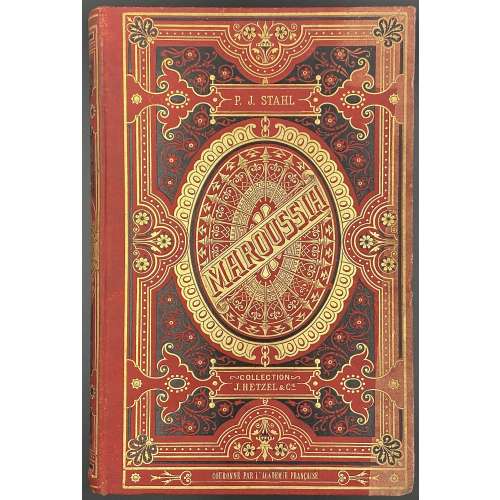 Title: MAROUSSIA | PAR | P.-J. STAHL | D'APRÈS UNE LÉGENDE DE MARKOWOVZOK | DESSINS PAR TH. SCHULER | GRAVURES PAR PANNEMAKER | {vignette} | BIBLIOTHÈQUE | D'ÉDUCATION ET DE RÉCRÉATION | J. HETZEL ET Cie, 18, RUE JACOB | PARIS | Tous droits de reproduction et de traduction réservés || Pagination: [2] – t.p. / blank, [1, 2] – dedication / blank, [3] 4-272, [1] 2-11 [12] – publisher’s advert.; Frontispiece and 22 leaves of wood-engraved plates by F. Pannemaker after Th. Schuler, extraneous to collation, woodcut head- and tailpieces, vignettes in the text by Charles Baude. Collation: 4to; 1-344, + 6 leaves of publisher's advertisement. Binding: “Cartonnage Hetzel” – red cloth stamped in gilt and black with the elements of design to spine, front and back, publisher's device to back, AEG. Author and publisher: Pierre-Jules Hetzel [P.-J. Stahl] (French, 1814 – 1886). Artist: Jules Théophile Schuler (French, 1821 – 1878). Engravers: Adolphe François Pannemaker (Belgian-French, 1822 – 1900) and Charles Baude (French, 1853 – 1935). Author of the legend: Markowovzok [Marko Vovchok; Марко́ Вовчо́к, real name Mariya Vilinskаya; Мария Александровна Вилинская] (Ukrainian, 1833 – 1907). Series: Collection Hetzel (stamped on the front board). Typographie A. Lahure (Paris), Alexis Lahure (French, 1849 – 1929). MAROUSSIA – The French version of the Ukrainian name Маруся.
Title: MAROUSSIA | PAR | P.-J. STAHL | D'APRÈS UNE LÉGENDE DE MARKOWOVZOK | DESSINS PAR TH. SCHULER | GRAVURES PAR PANNEMAKER | {vignette} | BIBLIOTHÈQUE | D'ÉDUCATION ET DE RÉCRÉATION | J. HETZEL ET Cie, 18, RUE JACOB | PARIS | Tous droits de reproduction et de traduction réservés || Pagination: [2] – t.p. / blank, [1, 2] – dedication / blank, [3] 4-272, [1] 2-11 [12] – publisher’s advert.; Frontispiece and 22 leaves of wood-engraved plates by F. Pannemaker after Th. Schuler, extraneous to collation, woodcut head- and tailpieces, vignettes in the text by Charles Baude. Collation: 4to; 1-344, + 6 leaves of publisher's advertisement. Binding: “Cartonnage Hetzel” – red cloth stamped in gilt and black with the elements of design to spine, front and back, publisher's device to back, AEG. Author and publisher: Pierre-Jules Hetzel [P.-J. Stahl] (French, 1814 – 1886). Artist: Jules Théophile Schuler (French, 1821 – 1878). Engravers: Adolphe François Pannemaker (Belgian-French, 1822 – 1900) and Charles Baude (French, 1853 – 1935). Author of the legend: Markowovzok [Marko Vovchok; Марко́ Вовчо́к, real name Mariya Vilinskаya; Мария Александровна Вилинская] (Ukrainian, 1833 – 1907). Series: Collection Hetzel (stamped on the front board). Typographie A. Lahure (Paris), Alexis Lahure (French, 1849 – 1929). MAROUSSIA – The French version of the Ukrainian name Маруся. -
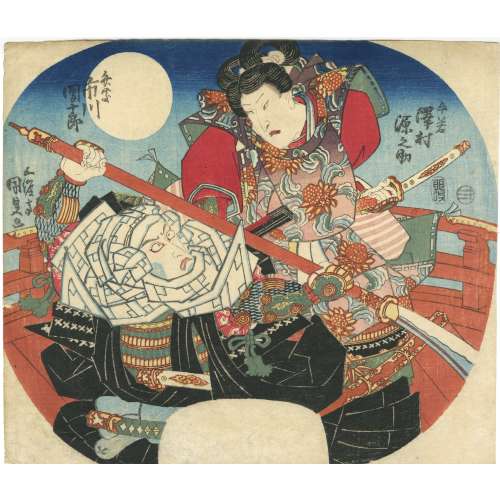 Sawamura Gennosuke II [沢村源之助] (Suketakaya Takasuke III, Sawamura Chōjūrō V, Sawamura Sōjūrō V, Sawamura Tosshō I, Sawamura Genpei I, Japanese, 1802/7 – 1853) as Ushiwakamaru [牛若丸], a.k.a. Minamoto no Yoshitsune [源 義経]. Ichikawa Danjūrō VII [市川団十郎] (Ichikawa Ebizō V, Ichikawa Hakuen II, Ichikawa Shinnosuke I, Japanese, 1791 – 1859) as Benkei, a.k.a. Saitō Musashibō Benkei [西塔武蔵坊弁慶] (Japanese, 1155 – 1189) Performance: Grand finale dance play [大切所作事] (ōgiri shosagoto) at Soga Festival - A Composite Piece of Musashi「曽我祭武蔵摂物 ごさいれいむさしのひきもの)」 (Gosairei Musashi no hikimono), performed at Kawarazakiza (河原崎座) in 05/1831 (See kabuki plays from 1831). Soga Festival (Soga Matsuri) is an annual theatre event in Edo (Tokyo). Scene: The Fight on Gojo Bridge or Benkei on the Bridge [橋弁慶] (Hashi Benkei). The story relates how Benkei, first a monk, then a mountain ascetic, and then a rogue warrior, a man of Herculean strength, was subdued by the young Onzoshi Ushiwaka Maru (Yoshitsune) on Gojo Bridge. Benkei wandered around Kyoto with the intention of relieving 1000 samurai of their swords. One night, with one more sword to go, he saw Yoshitsune playing the flute and wearing a golden sword at the Gojotenjin Shrine. They agreed to fight on Gojo Bridge in southern Kyoto. However, Yoshitsune was too agile for Benkei and had been educated in the secrets of fighting by the tengu. Following Yoshitsune’s victory, Benkei became Yoshitsune’s retainer. Artist: Utagawa Kunisada [歌川 国貞], a.k.a. Toyokuni III (Japanese, 1786 – 1865). Publisher: Ibaya Senzaburo [伊場屋仙三郎]. Signed: Gototei Kunisada ga [五渡亭国貞画]. Date-aratame seal: Tenpō 2 (1831). Size: Fan print (uchiwa-e). Ref.: (1) Tokyo Metropolitan Library, 請求記号 M339-6/東M339-006. (2) Ritsumeikan University, Art Research Center, Portal Database M339-006(02).
Sawamura Gennosuke II [沢村源之助] (Suketakaya Takasuke III, Sawamura Chōjūrō V, Sawamura Sōjūrō V, Sawamura Tosshō I, Sawamura Genpei I, Japanese, 1802/7 – 1853) as Ushiwakamaru [牛若丸], a.k.a. Minamoto no Yoshitsune [源 義経]. Ichikawa Danjūrō VII [市川団十郎] (Ichikawa Ebizō V, Ichikawa Hakuen II, Ichikawa Shinnosuke I, Japanese, 1791 – 1859) as Benkei, a.k.a. Saitō Musashibō Benkei [西塔武蔵坊弁慶] (Japanese, 1155 – 1189) Performance: Grand finale dance play [大切所作事] (ōgiri shosagoto) at Soga Festival - A Composite Piece of Musashi「曽我祭武蔵摂物 ごさいれいむさしのひきもの)」 (Gosairei Musashi no hikimono), performed at Kawarazakiza (河原崎座) in 05/1831 (See kabuki plays from 1831). Soga Festival (Soga Matsuri) is an annual theatre event in Edo (Tokyo). Scene: The Fight on Gojo Bridge or Benkei on the Bridge [橋弁慶] (Hashi Benkei). The story relates how Benkei, first a monk, then a mountain ascetic, and then a rogue warrior, a man of Herculean strength, was subdued by the young Onzoshi Ushiwaka Maru (Yoshitsune) on Gojo Bridge. Benkei wandered around Kyoto with the intention of relieving 1000 samurai of their swords. One night, with one more sword to go, he saw Yoshitsune playing the flute and wearing a golden sword at the Gojotenjin Shrine. They agreed to fight on Gojo Bridge in southern Kyoto. However, Yoshitsune was too agile for Benkei and had been educated in the secrets of fighting by the tengu. Following Yoshitsune’s victory, Benkei became Yoshitsune’s retainer. Artist: Utagawa Kunisada [歌川 国貞], a.k.a. Toyokuni III (Japanese, 1786 – 1865). Publisher: Ibaya Senzaburo [伊場屋仙三郎]. Signed: Gototei Kunisada ga [五渡亭国貞画]. Date-aratame seal: Tenpō 2 (1831). Size: Fan print (uchiwa-e). Ref.: (1) Tokyo Metropolitan Library, 請求記号 M339-6/東M339-006. (2) Ritsumeikan University, Art Research Center, Portal Database M339-006(02).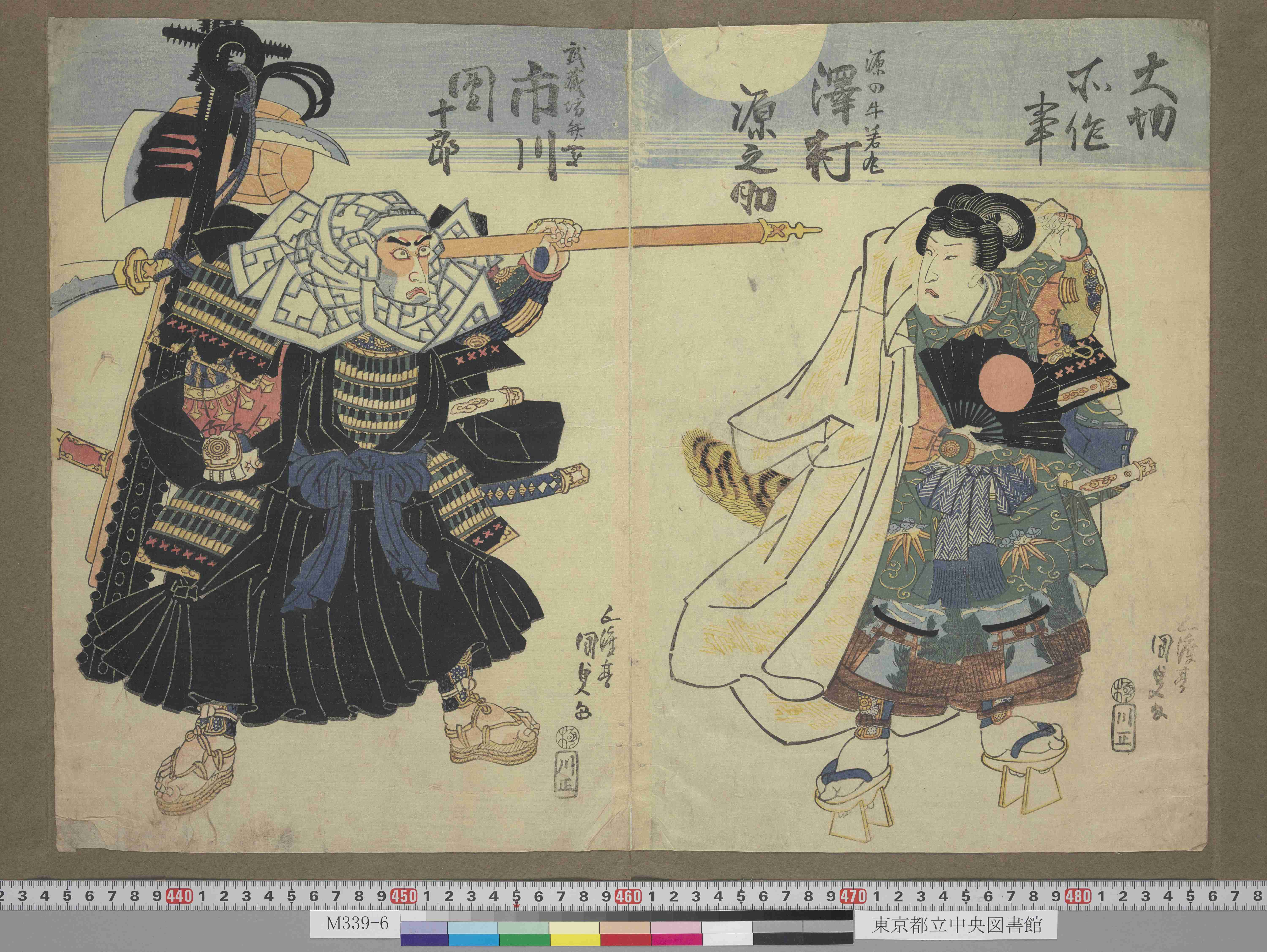
-
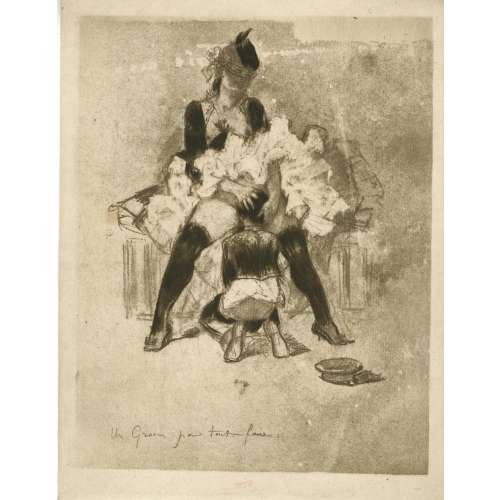
Etching on laid paper, depicting a kneeling groom with his head between the spread legs of a bare-breasted woman in a veiled hat. Inscribed on plate: Un groom a tout faire. Owner's stamp LVM on verso.
Dimensions: Paper: 24.4 x 15.8 cm; Image: 12 x 7.5 cm
Catalogue raisonné: Arthur Hubschmid (1977): 662.
-
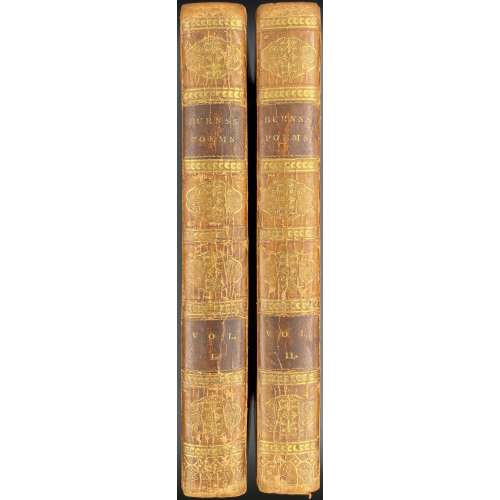 Description: Two volumes, collated 4to, usually described as 12mo, 16.5 x 10.5 cm each, uniformly bound in full calf, bordered in gilt with a triple-fillet over blind dentelle, flat spine ornamented in gilt with two crimson labels, gilt dentelle inside, blue marbled endpapers with previous owner bookplate to front pastedown in each vol.: "W. E. A. MACDONNELL. | NEW HALL | Co. of Clare.", and a ticket in a blue border “162”. Illustrated by T. Bewick after J. Thurston with frontispiece portrait of Robert Burns, numerous woodcut endpieces and a total of 14 full-page woodcut vignettes throughout. Title-page: THE | POETICAL WORKS | OF | ROBERT BURNS; | WITH HIS LIFE | ORNAMENTED WITH | ENGRAVINGS ON WOOD BY MR. BEWICK | FROM ORIGINAL DESIGNS BY MR. THURSTON. | — | IN TWO VOLUMES. | VOL I. (VOL. II.) | — | ALNWICK: | Printed by William Davison. | SOLD BY THE BOOKSELLERS IN ENGLAND, SCOTLAND | AND IRELAND. | – | 1808. || Vol. 1: Collation: π3 (1st blank, engraved frontispiece portrait of R. Burns, t.p.), a2 b-e4, A-Z4, 2A-2E4 (2E)4 (last two blank); total 137 leaves, numerous endpieces and 9 woodcut plates by Thomas Bewick after John Thurston within collation. Pagination: [2 blank] [i-v] 6 (i.e. vi) xlii [43-45] 46-268 (265-268 marked 263–266, respectively, [4 blank]; total 274 pages, of which 6 blank (pagination by Hugo: xlii, 297, 26), full-page plates opposite to pp. 73, 82, 106, 127, 141, 178, 192, 213, 219. Vol. 2: Collation: π5 (1st blank, t.p., 3 leaves of contents), A-B4 (C omitted) D-Z4, 2A-2G4 (2H omitted) 2I2 2K-2M4 2N1 χ2; total 138 leaves, numerous endpieces and 6 woodcut plates by Thomas Bewick after John Thurston within collation. Pagination: [2 blank] [i-iii] iv-xi (v marked vii, viii marked ix), 12-270 (16 marked 17, 76 marked 67, 84 marked 86, 96 marked 90, 112 marked 110, 203-207 marked 205-209, 220-224 marked 222-226), [4 blank]; total 276 pages, of which 6 blank (pagination by Hugo: xii, 320), full-page plates opposite to pp. 11, 40, 70, 191, 221. Catalogue raisonné: Hugo (1866): № 230, v. 1, p. 92-93; according to Hugo, the year 1808 was not stated, the number of pages in each volume is different to my copy. Provenance: Colonel William Edward Armstrong-Macdonnell (Irish, 1858 – 1883) of New Hall, Ennis, County Clare, Ireland (presumed). Contributors: Robert Burns (Scottish, 1759 – 1796) – author. Thomas Bewick (British, 1753 – 1828) – engraver. John Thurston (British, 1774 – 1822) – artist. William Davison (British, 1781 – 1858) – printer/publisher.
Description: Two volumes, collated 4to, usually described as 12mo, 16.5 x 10.5 cm each, uniformly bound in full calf, bordered in gilt with a triple-fillet over blind dentelle, flat spine ornamented in gilt with two crimson labels, gilt dentelle inside, blue marbled endpapers with previous owner bookplate to front pastedown in each vol.: "W. E. A. MACDONNELL. | NEW HALL | Co. of Clare.", and a ticket in a blue border “162”. Illustrated by T. Bewick after J. Thurston with frontispiece portrait of Robert Burns, numerous woodcut endpieces and a total of 14 full-page woodcut vignettes throughout. Title-page: THE | POETICAL WORKS | OF | ROBERT BURNS; | WITH HIS LIFE | ORNAMENTED WITH | ENGRAVINGS ON WOOD BY MR. BEWICK | FROM ORIGINAL DESIGNS BY MR. THURSTON. | — | IN TWO VOLUMES. | VOL I. (VOL. II.) | — | ALNWICK: | Printed by William Davison. | SOLD BY THE BOOKSELLERS IN ENGLAND, SCOTLAND | AND IRELAND. | – | 1808. || Vol. 1: Collation: π3 (1st blank, engraved frontispiece portrait of R. Burns, t.p.), a2 b-e4, A-Z4, 2A-2E4 (2E)4 (last two blank); total 137 leaves, numerous endpieces and 9 woodcut plates by Thomas Bewick after John Thurston within collation. Pagination: [2 blank] [i-v] 6 (i.e. vi) xlii [43-45] 46-268 (265-268 marked 263–266, respectively, [4 blank]; total 274 pages, of which 6 blank (pagination by Hugo: xlii, 297, 26), full-page plates opposite to pp. 73, 82, 106, 127, 141, 178, 192, 213, 219. Vol. 2: Collation: π5 (1st blank, t.p., 3 leaves of contents), A-B4 (C omitted) D-Z4, 2A-2G4 (2H omitted) 2I2 2K-2M4 2N1 χ2; total 138 leaves, numerous endpieces and 6 woodcut plates by Thomas Bewick after John Thurston within collation. Pagination: [2 blank] [i-iii] iv-xi (v marked vii, viii marked ix), 12-270 (16 marked 17, 76 marked 67, 84 marked 86, 96 marked 90, 112 marked 110, 203-207 marked 205-209, 220-224 marked 222-226), [4 blank]; total 276 pages, of which 6 blank (pagination by Hugo: xii, 320), full-page plates opposite to pp. 11, 40, 70, 191, 221. Catalogue raisonné: Hugo (1866): № 230, v. 1, p. 92-93; according to Hugo, the year 1808 was not stated, the number of pages in each volume is different to my copy. Provenance: Colonel William Edward Armstrong-Macdonnell (Irish, 1858 – 1883) of New Hall, Ennis, County Clare, Ireland (presumed). Contributors: Robert Burns (Scottish, 1759 – 1796) – author. Thomas Bewick (British, 1753 – 1828) – engraver. John Thurston (British, 1774 – 1822) – artist. William Davison (British, 1781 – 1858) – printer/publisher. -
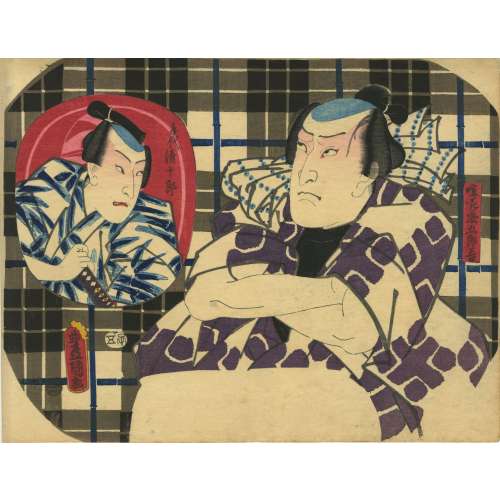 Artist: Utagawa Kunisada [歌川 国貞] a.k.a. Utagawa Toyokuni III [三代歌川豊国] (Japanese, 1786 – 1865). Publisher: Ibaya Senzaburō [伊場屋仙三郎] (Japanese, fl. C. 1845 – 1847). Date seal: [子五] Kaei 5, 5th month (5/1852). Signed: Toyokuni ga [豊国 画] in a red toshidama cartouche. Title: Actor Bandō Takesaburō I as clerk Seijūrō [手代清十郎] (left) and Actor Ichikawa Kodanji IV as Kenkaya Gorōkichi [喧嘩屋五郎吉] (right) in the play Musume ōgi tsui no tatehiki [娘扇一対侠贔屓 (むすめおうぎついのたてひき)] performed at the Nakamura theatre [中村座], in Edo (Tokyo). The playbill for this performance can be found at MFA (Boston) # 11.28042, 11.28285, 11.28286:
Artist: Utagawa Kunisada [歌川 国貞] a.k.a. Utagawa Toyokuni III [三代歌川豊国] (Japanese, 1786 – 1865). Publisher: Ibaya Senzaburō [伊場屋仙三郎] (Japanese, fl. C. 1845 – 1847). Date seal: [子五] Kaei 5, 5th month (5/1852). Signed: Toyokuni ga [豊国 画] in a red toshidama cartouche. Title: Actor Bandō Takesaburō I as clerk Seijūrō [手代清十郎] (left) and Actor Ichikawa Kodanji IV as Kenkaya Gorōkichi [喧嘩屋五郎吉] (right) in the play Musume ōgi tsui no tatehiki [娘扇一対侠贔屓 (むすめおうぎついのたてひき)] performed at the Nakamura theatre [中村座], in Edo (Tokyo). The playbill for this performance can be found at MFA (Boston) # 11.28042, 11.28285, 11.28286: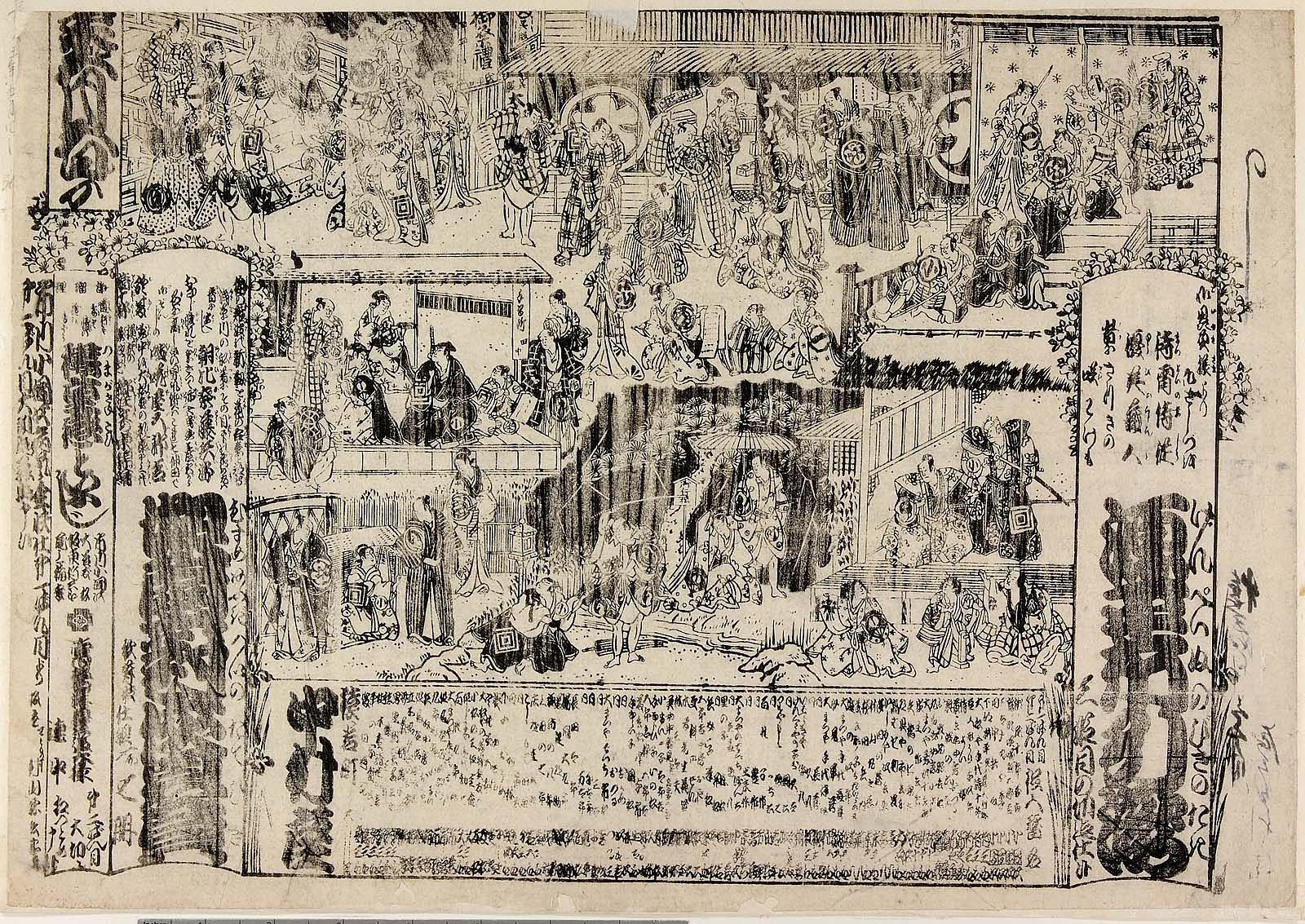 Actors:
Bandō Takesaburō I (初代坂東竹三郎) (Japanese, 1832 – 1877); other names: Shinshi, Shinsui V, Bandō Hikosaburō V [五代目坂東彦三郎], Bandō Tsurunosuke I.
Ichikawa Kodanji IV [市川小團次] (Japanese, 1812 – 1866); other names: Ichikawa Yonejūrō I, Ichikawa Yonezō III, Ichikawa Eizō.
Actors:
Bandō Takesaburō I (初代坂東竹三郎) (Japanese, 1832 – 1877); other names: Shinshi, Shinsui V, Bandō Hikosaburō V [五代目坂東彦三郎], Bandō Tsurunosuke I.
Ichikawa Kodanji IV [市川小團次] (Japanese, 1812 – 1866); other names: Ichikawa Yonejūrō I, Ichikawa Yonezō III, Ichikawa Eizō.
Similar images were then used for the series Seven flourishing plants on lanterns for summer evenings [涼調珍盛の七草] (Suzumi chōchin sakari no nanakusa) published by Ibaya Senzaburō in 1852 (Kaei 5), 6th month.
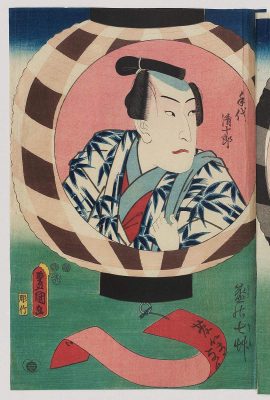
Bandō Takesaburō I (carved by Yokokawa Takejirō): https://collections.mfa.org/objects/219360
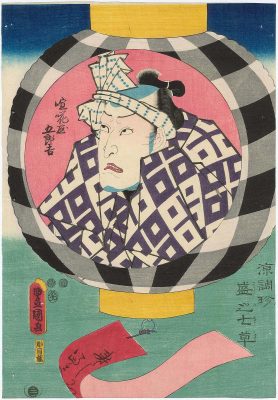
Actor Ichikawa Kodanji IV (carved by Nakamura Tōkichi): https://collections.mfa.org/objects/477146.
-
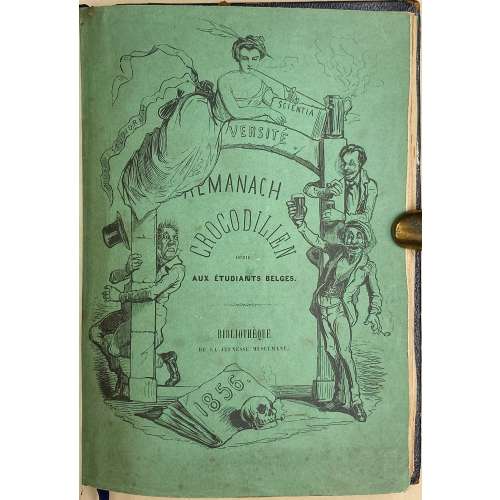 One volume collated 8vo, 19 x 14 cm, bound in black alligator leather. Front wrapper (green) / title-page (white): A female figure smoking a pipe next to a beer mug, reclining over an arch ring lettered “…VERSITÉ” (UNI… not shown), her dress ribbon lettered “MUSA STUDIORUM”, holding a book lettered “SCIENTIA”; within the arch « ALMANACH | CROCODILIEN | DÉDIÉ | AUX ÉTUDIANTS BELGES. | BIBLIOTHÈQUE | DE LA JEUNESSE MUSULMANE. »; below lies a book lettered “1856.”, next to it is a smoking skull; three male figures embracing the arch columns. Half-title: ALMANACH CROCODILIEN | POUR | L’ANNÉE BISSEXTILE, MAIS NÉANMOINS DE GRACE | 1856. || Pagination: [1-5] 6-14 [15-41] 42-134 [137] 138, total 136 pages within the wrappers, original publisher's green wrappers preserved, carte de visite ‘Félicien Rops, Étudiant’ and pink invitation card № 129 for ‘Bal des femmes’ on March 19, 1892 at ‘Fête annuelle du Courier Français’ bound in; in-text woodcuts, initials, head- and tail-pieces after Félicien Rops. Bookplate “Ex Libris Marcellus Schlimovich” with motto “Ars naturam adiuvat” on front pastedown. Stamp of the "Sociedad Hebraica Argentina / Coleccion M. Schlimovich / Varios / No. 2-492” to half-title. Pencil inscription to half-title: "Ex. Félicien Rops" – possibly an own copy of the artist. Collation: π2 1-88 92, total 68 leaves within wrappers. Printer: Typ. de J. Vanbuggenhoudt (Bruxelles). Sociedad Hebraica Argentina; Marcelo Schlimovich (Argentine-Jewish, ca. 1880 – 1960) – provenance. Félicien Rops (Belgian, 1833 – 1898) – artist.
One volume collated 8vo, 19 x 14 cm, bound in black alligator leather. Front wrapper (green) / title-page (white): A female figure smoking a pipe next to a beer mug, reclining over an arch ring lettered “…VERSITÉ” (UNI… not shown), her dress ribbon lettered “MUSA STUDIORUM”, holding a book lettered “SCIENTIA”; within the arch « ALMANACH | CROCODILIEN | DÉDIÉ | AUX ÉTUDIANTS BELGES. | BIBLIOTHÈQUE | DE LA JEUNESSE MUSULMANE. »; below lies a book lettered “1856.”, next to it is a smoking skull; three male figures embracing the arch columns. Half-title: ALMANACH CROCODILIEN | POUR | L’ANNÉE BISSEXTILE, MAIS NÉANMOINS DE GRACE | 1856. || Pagination: [1-5] 6-14 [15-41] 42-134 [137] 138, total 136 pages within the wrappers, original publisher's green wrappers preserved, carte de visite ‘Félicien Rops, Étudiant’ and pink invitation card № 129 for ‘Bal des femmes’ on March 19, 1892 at ‘Fête annuelle du Courier Français’ bound in; in-text woodcuts, initials, head- and tail-pieces after Félicien Rops. Bookplate “Ex Libris Marcellus Schlimovich” with motto “Ars naturam adiuvat” on front pastedown. Stamp of the "Sociedad Hebraica Argentina / Coleccion M. Schlimovich / Varios / No. 2-492” to half-title. Pencil inscription to half-title: "Ex. Félicien Rops" – possibly an own copy of the artist. Collation: π2 1-88 92, total 68 leaves within wrappers. Printer: Typ. de J. Vanbuggenhoudt (Bruxelles). Sociedad Hebraica Argentina; Marcelo Schlimovich (Argentine-Jewish, ca. 1880 – 1960) – provenance. Félicien Rops (Belgian, 1833 – 1898) – artist. -
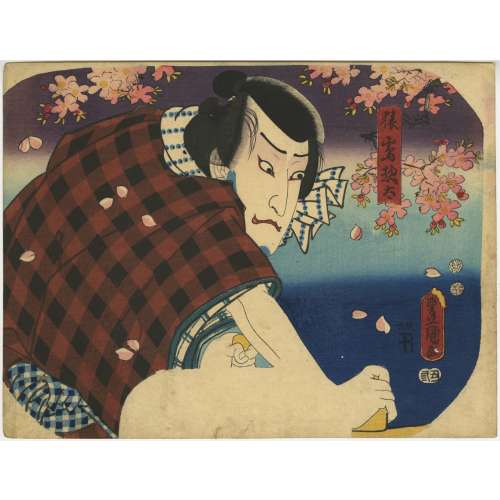 Kabuki actor Arashi Kichisaburō III [嵐吉三郎] as Sarushima Sōta [猿島惣太] in the play Hanamo Yoshida Iwao no Matsuwaka [花吉田岩尾松若] staged at Ichimura-za (市村座), theatre in Edo. Artist: Utagawa Kunisada, a.k.a. Toyokuni III (Japanese, 1786 – 1865) [歌川 国貞]. Publisher: Kojimaya Jūbei (Japanese, 1797-1869), seal: Hanmoto, Jū [板元, 十] (Marks 19-043 | 264c. Date seal and double nanushi censor seals Mera & Watanabe – 3rd month of Kaei 6 (1853). Signed: Toyokuni ga [豊国 画] in a red toshidama cartouche. Media: Fan print (uchiwa-e), 223 x 294 mm. Kabuki actor Arashi Kichisaburō III [嵐吉三郎] (Japanese, 1810 – 1864); other names: Arashi Daizaburō III, Arashi Kitsusaburō III Ref.: Art shop Ezoshi Ukiyoe new collection news, vol. 66, 2023.1 (Jan) # 30, p.8.
Kabuki actor Arashi Kichisaburō III [嵐吉三郎] as Sarushima Sōta [猿島惣太] in the play Hanamo Yoshida Iwao no Matsuwaka [花吉田岩尾松若] staged at Ichimura-za (市村座), theatre in Edo. Artist: Utagawa Kunisada, a.k.a. Toyokuni III (Japanese, 1786 – 1865) [歌川 国貞]. Publisher: Kojimaya Jūbei (Japanese, 1797-1869), seal: Hanmoto, Jū [板元, 十] (Marks 19-043 | 264c. Date seal and double nanushi censor seals Mera & Watanabe – 3rd month of Kaei 6 (1853). Signed: Toyokuni ga [豊国 画] in a red toshidama cartouche. Media: Fan print (uchiwa-e), 223 x 294 mm. Kabuki actor Arashi Kichisaburō III [嵐吉三郎] (Japanese, 1810 – 1864); other names: Arashi Daizaburō III, Arashi Kitsusaburō III Ref.: Art shop Ezoshi Ukiyoe new collection news, vol. 66, 2023.1 (Jan) # 30, p.8. -
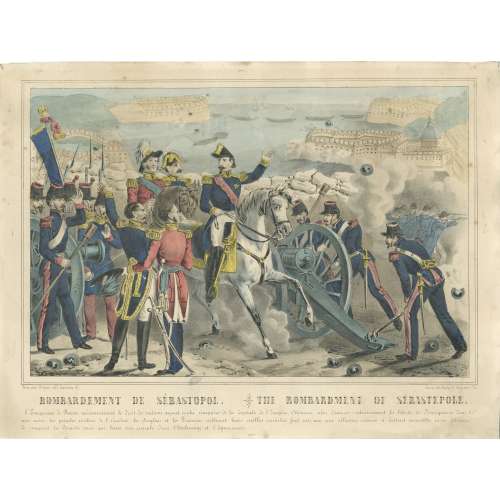 Hand-coloured lithography on wove paper, 250 x 332 mm; black ink stamp “5035” to reverse. Under the frame left: "Paris, chez Riboni, éd. r. Galande, 51"; right: "Paris, lith. Bulla, Pl. Maubert, 26". Below: "BOMBARDEMENT DE SEBASTOPOL. — THE BOMBARDMENT OF SÉBASTOPOLE". Text to bottom. Printers/publishers: Antoine Bulla (fl. 1815 – 1877), François Bulla (fl. c. 1814 – 1855).
Hand-coloured lithography on wove paper, 250 x 332 mm; black ink stamp “5035” to reverse. Under the frame left: "Paris, chez Riboni, éd. r. Galande, 51"; right: "Paris, lith. Bulla, Pl. Maubert, 26". Below: "BOMBARDEMENT DE SEBASTOPOL. — THE BOMBARDMENT OF SÉBASTOPOLE". Text to bottom. Printers/publishers: Antoine Bulla (fl. 1815 – 1877), François Bulla (fl. c. 1814 – 1855). -
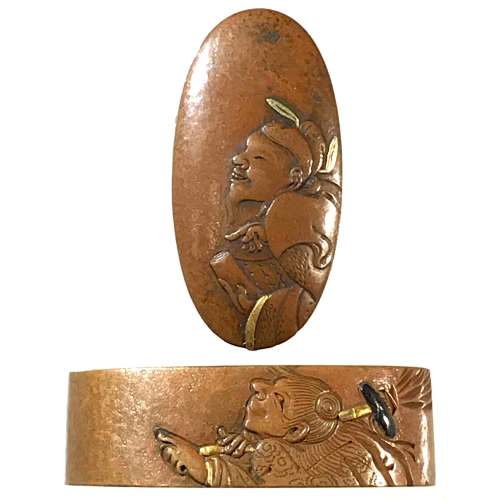 Fuchi-kashira of copper, carved and inlaid with gold and shakudō, with the design of Kanzan (on kashira), Chinese: Hanshan, an eccentric poet of the Tang dynasty with a scroll (618-906) who befriended Jittoku (on fuchi, Chinese: Shide, a kitchen helper at a mountain temple, holding a broom). Fuchi is signed Josui (如⽔). Fuchi (Jittoku, holding a broom): 38 x 22 x 12 mm. Weight: 23g (Nakago hole: 27 x 8.5 mm); Kashira (Kanzan, reading a scroll): 34 x 17 x 9 mm. Weight: 10g. Materials: Copper, gold, shakudō. Techniques: Tsuchi-me-ji (hammer-marked surface); usu-shishiai-bori or usuniku-bori (low-relief carving which leaves the image somewhat higher than the surface - high relief effect); zōgan (inlay). Josui was a daughter of Jochiku Kamo (Markus Sesko, Genealogies).
Fuchi-kashira of copper, carved and inlaid with gold and shakudō, with the design of Kanzan (on kashira), Chinese: Hanshan, an eccentric poet of the Tang dynasty with a scroll (618-906) who befriended Jittoku (on fuchi, Chinese: Shide, a kitchen helper at a mountain temple, holding a broom). Fuchi is signed Josui (如⽔). Fuchi (Jittoku, holding a broom): 38 x 22 x 12 mm. Weight: 23g (Nakago hole: 27 x 8.5 mm); Kashira (Kanzan, reading a scroll): 34 x 17 x 9 mm. Weight: 10g. Materials: Copper, gold, shakudō. Techniques: Tsuchi-me-ji (hammer-marked surface); usu-shishiai-bori or usuniku-bori (low-relief carving which leaves the image somewhat higher than the surface - high relief effect); zōgan (inlay). Josui was a daughter of Jochiku Kamo (Markus Sesko, Genealogies). -
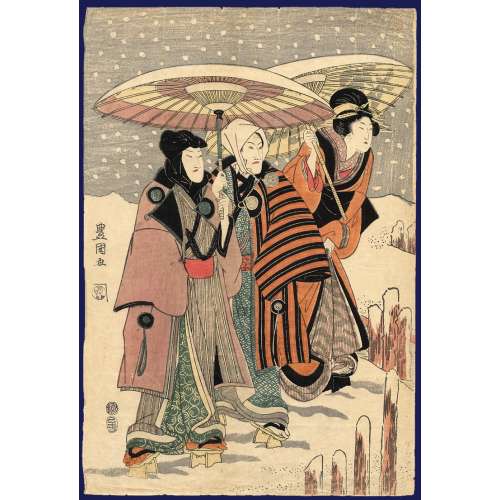 Similar image at MFA under title: Actors and Women in the Snow MFA ACCESSION NUMBER: 11.13568 Date: 1809 (Bunka 6), 12th month Artist: Utagawa Toyokuni I (1769–1825) Publisher Tsuruya Kinsuke (firm name Sôkakudô), № 554 in Marks's "Publishers". DIMENSIONS: Vertical ôban; 38.2 x 25.8 cm (15 1/16 x 10 3/16 in.) MEDIUM OR TECHNIQUE: Woodblock print (nishiki-e); ink and color on paper. Signed: Toyokuni ga (豊国画) Censor's seals: kiwame (改印:極) MFA assumes that this may be "one sheet of incomplete triptych?"
Similar image at MFA under title: Actors and Women in the Snow MFA ACCESSION NUMBER: 11.13568 Date: 1809 (Bunka 6), 12th month Artist: Utagawa Toyokuni I (1769–1825) Publisher Tsuruya Kinsuke (firm name Sôkakudô), № 554 in Marks's "Publishers". DIMENSIONS: Vertical ôban; 38.2 x 25.8 cm (15 1/16 x 10 3/16 in.) MEDIUM OR TECHNIQUE: Woodblock print (nishiki-e); ink and color on paper. Signed: Toyokuni ga (豊国画) Censor's seals: kiwame (改印:極) MFA assumes that this may be "one sheet of incomplete triptych?" -
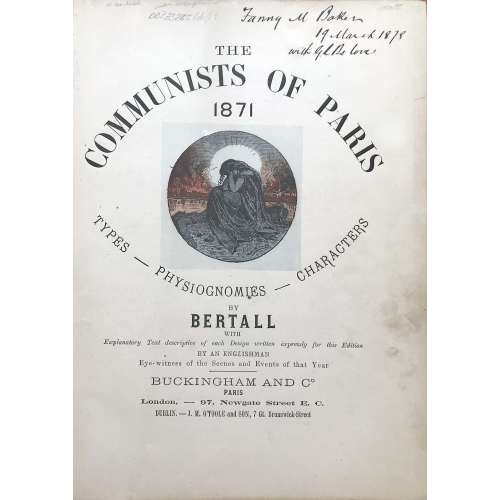 Folio (246 x 321 mm), hardbound in red-brown cloth with gilt lettering and decoration. Content, Introduction by J. E., September, 1873, Artist preface by Bertall, Paris, 1871-1873. Album with 40 hand-colored lithographs by Bertall, numbered 1 through 40, accompanied with extensive descriptions. Ex Libris: Baker. Carpe Diem. Markings: Janny M. Baker with J.L.B. Love, 19 March, 1878 in black ink.
Folio (246 x 321 mm), hardbound in red-brown cloth with gilt lettering and decoration. Content, Introduction by J. E., September, 1873, Artist preface by Bertall, Paris, 1871-1873. Album with 40 hand-colored lithographs by Bertall, numbered 1 through 40, accompanied with extensive descriptions. Ex Libris: Baker. Carpe Diem. Markings: Janny M. Baker with J.L.B. Love, 19 March, 1878 in black ink. -
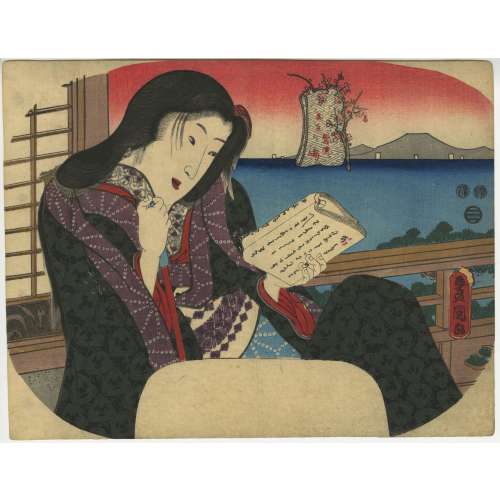 Artist: Utagawa Kunisada [歌川 国貞] a.k.a. Utagawa Toyokuni III [三代歌川豊国] (Japanese, 1786 – 1865). Signed: Toyokuni ga [豊国 画] in a red toshidama cartouche. Publisher: Ibaya Senzaburō [伊場屋仙三郎] (Japanese, c. 1815 – 1869). Double nanushi censor seals: Hama & Magome, Kaei 2-5 (1849 – 1852). An uncut fan print (uchiwa-e, 220 x 292 mm) depicts a beautiful woman sitting on a balcony overlooking a bay and reading a book. Above the book, there is an obi with a pattern of stripes or modified key fret motif, with lettering that reads: 菅原島 [Sugawara-jima] and 美立 [mitate]. The lettering and the blossoming plum branch next to the obi provide an allusion to Sugawara no Michizane [菅原 道真/菅原 道眞] (Japanese, 845 – 903) - a prominent scholar and poet of Heian period exiled from Kyoto to the island of Kyushu as a result of another courtier's slander. A legend says that his beloved plum tree was so fond of its master that it flew to Kyushu with Sugawara. The Davis Museum at Wellesley College describes the print as belonging to the series A Parody of Sugawara Stripe Patterns (Mitate Sugawara-jima). To make the fact of an allusion transparent, Kunisada had changed the usual way of writing "Sugawara stripes" from 菅原縞 to 菅原島 and "mitate" from 見立 to 美立. An unusual spelling was also used to provide additional information to the reader in other cultures. E.g. during the Prohibition Era, the West Coast United States speakeasy bars and bordellos misspelt the items on a menu ("scollops") or in a neon sign ("Martuni's") to tell: here we have more pleasures for you than you may have expected. After Tenpō reforms, the printing of bijin-ga (美人画, "picture of beautiful woman") images was restricted. Our print disguises a typical bijin-ga as an advertisement of an obi (帯, a kimono sash) fabric pattern. "The market of portraits was satisfied and the authorities fooled" [Rebecca Salter. Japanese popular prints. — Honolulu: University of Hawaii Press, 2006].
Artist: Utagawa Kunisada [歌川 国貞] a.k.a. Utagawa Toyokuni III [三代歌川豊国] (Japanese, 1786 – 1865). Signed: Toyokuni ga [豊国 画] in a red toshidama cartouche. Publisher: Ibaya Senzaburō [伊場屋仙三郎] (Japanese, c. 1815 – 1869). Double nanushi censor seals: Hama & Magome, Kaei 2-5 (1849 – 1852). An uncut fan print (uchiwa-e, 220 x 292 mm) depicts a beautiful woman sitting on a balcony overlooking a bay and reading a book. Above the book, there is an obi with a pattern of stripes or modified key fret motif, with lettering that reads: 菅原島 [Sugawara-jima] and 美立 [mitate]. The lettering and the blossoming plum branch next to the obi provide an allusion to Sugawara no Michizane [菅原 道真/菅原 道眞] (Japanese, 845 – 903) - a prominent scholar and poet of Heian period exiled from Kyoto to the island of Kyushu as a result of another courtier's slander. A legend says that his beloved plum tree was so fond of its master that it flew to Kyushu with Sugawara. The Davis Museum at Wellesley College describes the print as belonging to the series A Parody of Sugawara Stripe Patterns (Mitate Sugawara-jima). To make the fact of an allusion transparent, Kunisada had changed the usual way of writing "Sugawara stripes" from 菅原縞 to 菅原島 and "mitate" from 見立 to 美立. An unusual spelling was also used to provide additional information to the reader in other cultures. E.g. during the Prohibition Era, the West Coast United States speakeasy bars and bordellos misspelt the items on a menu ("scollops") or in a neon sign ("Martuni's") to tell: here we have more pleasures for you than you may have expected. After Tenpō reforms, the printing of bijin-ga (美人画, "picture of beautiful woman") images was restricted. Our print disguises a typical bijin-ga as an advertisement of an obi (帯, a kimono sash) fabric pattern. "The market of portraits was satisfied and the authorities fooled" [Rebecca Salter. Japanese popular prints. — Honolulu: University of Hawaii Press, 2006]. -
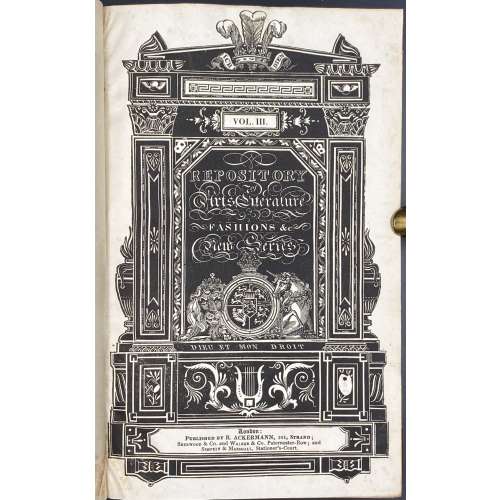 Pagination: [2] – letterpress title / blank, t.p. contents / to readers, [1] 2-368 [4 index], + 6 b/w (one folding) and 28 coloured plates (total 34). Collation: 4to; letterpress title, [A]1 B-Z4 Aa-Zz4 3A-3B4 3C3. Binding: 25 x 16 cm; gilt-ruled half-calf over marbled boards, flat spine, gilt-ruled compartments, gilt lettering. 5 aquatints by Thomas Rowlandson (British, 1757 – 1827): Table D'Hote; Consulting the Prophet; The Prophet discovering himself and exposing the deception; The Arrival in Paris; Liberality to infirm beggars on leaving Yrvi. References: Martin Hardie (1906), p.310 [LIB-2623.2021]; R. V. Tooley (1935), p. 26 [LIB-2641.2021]; J. R. Abbey (1953), Cat. № 212, p. 167 [LIB-2622.2021].
Pagination: [2] – letterpress title / blank, t.p. contents / to readers, [1] 2-368 [4 index], + 6 b/w (one folding) and 28 coloured plates (total 34). Collation: 4to; letterpress title, [A]1 B-Z4 Aa-Zz4 3A-3B4 3C3. Binding: 25 x 16 cm; gilt-ruled half-calf over marbled boards, flat spine, gilt-ruled compartments, gilt lettering. 5 aquatints by Thomas Rowlandson (British, 1757 – 1827): Table D'Hote; Consulting the Prophet; The Prophet discovering himself and exposing the deception; The Arrival in Paris; Liberality to infirm beggars on leaving Yrvi. References: Martin Hardie (1906), p.310 [LIB-2623.2021]; R. V. Tooley (1935), p. 26 [LIB-2641.2021]; J. R. Abbey (1953), Cat. № 212, p. 167 [LIB-2622.2021]. -
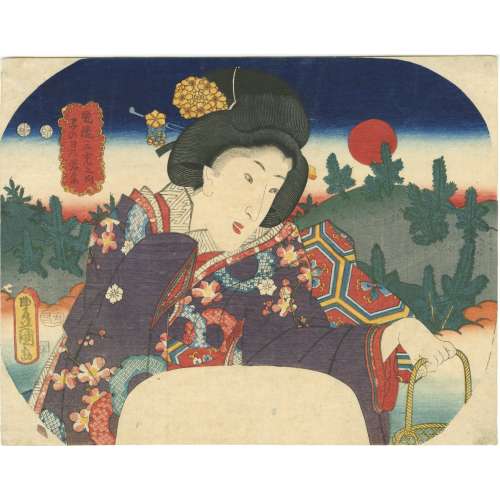 An uncut fan print shows a young woman holding a basket on a landscape background with hills and pines under a rising sun. Haruo Shirane: "Under the luni-solar calendar, the New Year coincided with the beginning of spring, making it the most important observance of the year for the aristocracy. In the Heian period, New Year ceremonies extended from New Year’s Day (Ganjitsu) to the Day of the Rat (Nenohi), which usually fell on the seventh day of the First Month, when courtiers went out to the fields (no), pulled up small pines, and gathered new herbs (wakana) as a prayer for long life. This ritual gradually spread to the provinces and to commoners, eventually resulting in the New Year practice of the gate pine (kadomatsu), in which a pair of small pines was placed at the gate of a house. A popular Heian-period painting topic representing the First Month was “prayers on the Day of the Rat” (Nenohi no asobi), which depicted the auspicious scene of pulling up small pines in a spring field. Both young herbs and gathering young herbs, particularly at Kasuga Field, became major poetic topics for the First Month, appearing in both the spring and celebration (ga) books of the Kokinshū (Collection of Japanese Poems Old and New, ca. 905). By the Kamakura period, the observance of the Day of the Rat had been abandoned at the imperial court, but the custom of gathering and eating young greens continued as the annual ceremony known as the Seven Grasses (Nanakusa). Note: The Heian-period ritual of pulling up the roots of small pines (komatsu ) on the first Day of the Rat derives from the homonyms ne (rat) and ne (root). Pulling up roots was auspicious, since it implied lengthening the year. The rising sun (hinode) was considered an auspicious sight, particularly at the beginning of the year". [Haruo Shirane, Japan and the Culture of the Four Seasons. Nature, Literature, and the Arts. — Columbia University, NY, 2012]. Title: Gathering of the young herbs on the Day of the Rat [子の日乃若菜] (Nenohi no wakana). Series: Three elegant sources of light [風流三光の内] (fūryū sankō no uchi); meaning the sun, the moon and the stars). Artist: Utagawa Kunisada [歌川 国貞]; a.k.a. Utagawa Toyokuni III [三代歌川豊国] (Japanese, 1786 – 1865). Signed: Toyokuni ga [豊国 画] in a yellow toshidama cartouche. Publisher’s seal: Izuzen (Marks: seal 06-029 | U103b) Date and double nanushi censor seals: Mera and Watanabe, Kaei 6 (1853). A similar theme can be found in Kunisadai's triptych published in about 1844 (HARA SHOBO):
An uncut fan print shows a young woman holding a basket on a landscape background with hills and pines under a rising sun. Haruo Shirane: "Under the luni-solar calendar, the New Year coincided with the beginning of spring, making it the most important observance of the year for the aristocracy. In the Heian period, New Year ceremonies extended from New Year’s Day (Ganjitsu) to the Day of the Rat (Nenohi), which usually fell on the seventh day of the First Month, when courtiers went out to the fields (no), pulled up small pines, and gathered new herbs (wakana) as a prayer for long life. This ritual gradually spread to the provinces and to commoners, eventually resulting in the New Year practice of the gate pine (kadomatsu), in which a pair of small pines was placed at the gate of a house. A popular Heian-period painting topic representing the First Month was “prayers on the Day of the Rat” (Nenohi no asobi), which depicted the auspicious scene of pulling up small pines in a spring field. Both young herbs and gathering young herbs, particularly at Kasuga Field, became major poetic topics for the First Month, appearing in both the spring and celebration (ga) books of the Kokinshū (Collection of Japanese Poems Old and New, ca. 905). By the Kamakura period, the observance of the Day of the Rat had been abandoned at the imperial court, but the custom of gathering and eating young greens continued as the annual ceremony known as the Seven Grasses (Nanakusa). Note: The Heian-period ritual of pulling up the roots of small pines (komatsu ) on the first Day of the Rat derives from the homonyms ne (rat) and ne (root). Pulling up roots was auspicious, since it implied lengthening the year. The rising sun (hinode) was considered an auspicious sight, particularly at the beginning of the year". [Haruo Shirane, Japan and the Culture of the Four Seasons. Nature, Literature, and the Arts. — Columbia University, NY, 2012]. Title: Gathering of the young herbs on the Day of the Rat [子の日乃若菜] (Nenohi no wakana). Series: Three elegant sources of light [風流三光の内] (fūryū sankō no uchi); meaning the sun, the moon and the stars). Artist: Utagawa Kunisada [歌川 国貞]; a.k.a. Utagawa Toyokuni III [三代歌川豊国] (Japanese, 1786 – 1865). Signed: Toyokuni ga [豊国 画] in a yellow toshidama cartouche. Publisher’s seal: Izuzen (Marks: seal 06-029 | U103b) Date and double nanushi censor seals: Mera and Watanabe, Kaei 6 (1853). A similar theme can be found in Kunisadai's triptych published in about 1844 (HARA SHOBO):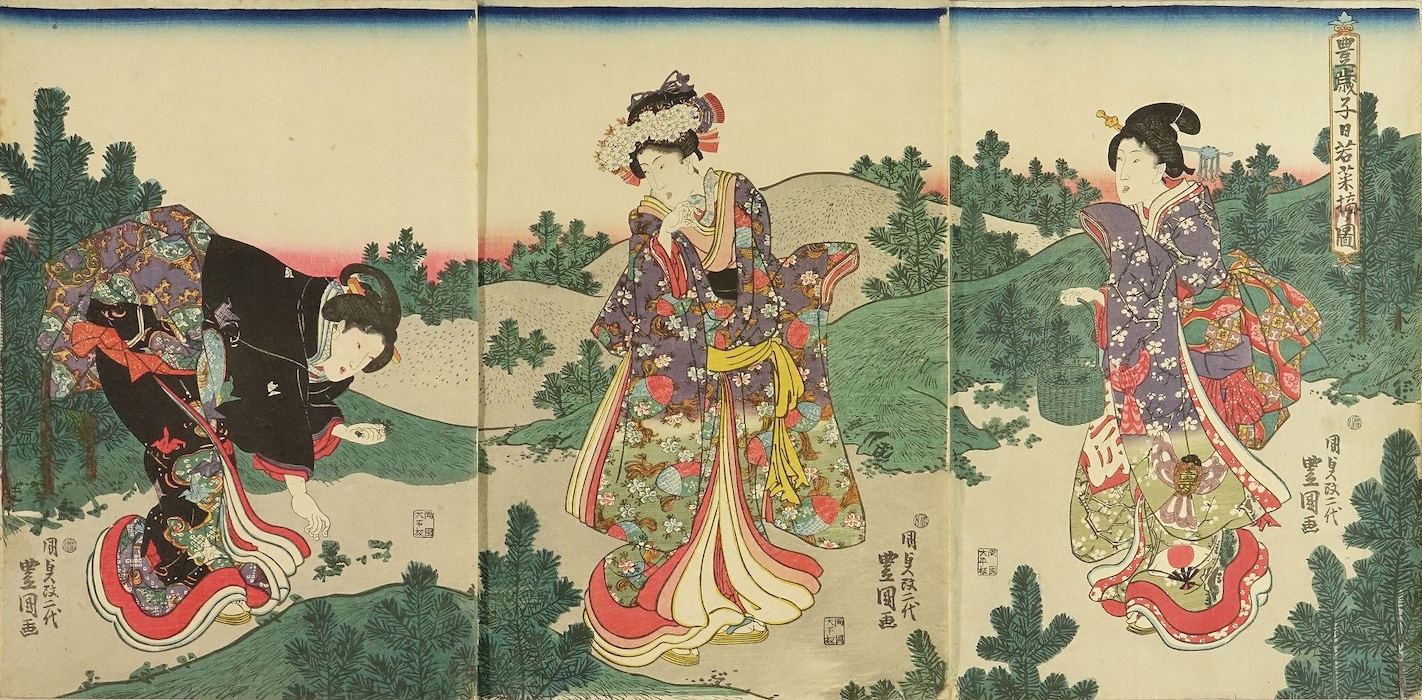
豊国三代「豊歳子日若菜摘ノ図」
-
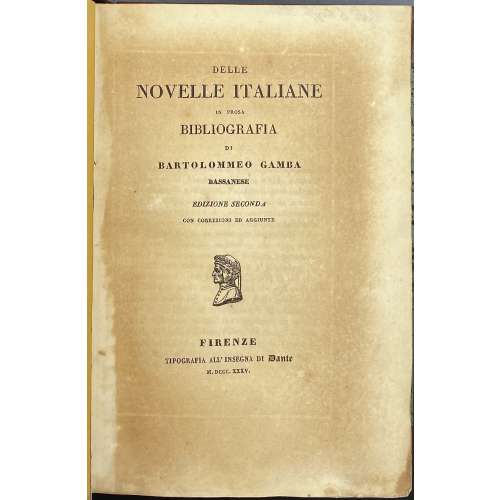 Title-page: DELLE | NOVELLE ITALIANE | IN PROSA | BIBLIOGRAFIA | DI | BARTOLOMMEO GAMBA | BASSANESE | EDIZIONE SECONDA | CON CORREZIONI ED AGGIUNTE | {publisher’s device} | FIRENZE | TIPOGRAFIA ALL’INSEGNA DI Dante | M.DCCC.XXXV. || Collation: 8vo; π8 1-198; an extra leaf between 18 and 19 (189, pp. 289-10, errata), leaf 11 unsigned, leaf 12 signed 11. Total 161 leaves plus 6 leaves of plates extraneous to collation; Plates (copperplate engravings): (1) Giovanni Boccaccio, (2) Angelo Firezuola (i.e. Agnolo Firenzuola), (3) Lorenzo Magalotti, (4) Gasparo Gozzi, and (5) Michele Colombo by Marco Comirato, and (6) Franco Sacchetti by Francesco Bosa. Pagination: [i-iii] iv-xv [xvi] [1-3] 4-290, index [16], total 322 pages plus 6 plates, unpaginated. Binding: 22.4 x 15 cm, modern brown half-morocco over green sprinkled boards, red label with gilt lettering, publisher’s yellow wrappers preserved. Edition: 2nd; the 1st edition was published in 1833. Contributors: Bartolommeo Gamba (Italian, 1766 – 1841) – author, complier. Marco Comirato (Italian, c. 1800 – 1869) – engraver. Francesco Bosa (Italian, ? – ?) – engraver. Sitters: Giovanni Boccaccio (Italian, 1313 –1375) Franco Sacchetti (Italian, c. 1335 – c. 1400) Agnolo Firenzuola] (Italian, 1493 – 1543) Lorenzo Magalotti (Italian, 1637 – 1712) Gasparo Gozzi (Italian, 1713 – 1786) Michele Colombo (Italian, 1747 – 1838)
Title-page: DELLE | NOVELLE ITALIANE | IN PROSA | BIBLIOGRAFIA | DI | BARTOLOMMEO GAMBA | BASSANESE | EDIZIONE SECONDA | CON CORREZIONI ED AGGIUNTE | {publisher’s device} | FIRENZE | TIPOGRAFIA ALL’INSEGNA DI Dante | M.DCCC.XXXV. || Collation: 8vo; π8 1-198; an extra leaf between 18 and 19 (189, pp. 289-10, errata), leaf 11 unsigned, leaf 12 signed 11. Total 161 leaves plus 6 leaves of plates extraneous to collation; Plates (copperplate engravings): (1) Giovanni Boccaccio, (2) Angelo Firezuola (i.e. Agnolo Firenzuola), (3) Lorenzo Magalotti, (4) Gasparo Gozzi, and (5) Michele Colombo by Marco Comirato, and (6) Franco Sacchetti by Francesco Bosa. Pagination: [i-iii] iv-xv [xvi] [1-3] 4-290, index [16], total 322 pages plus 6 plates, unpaginated. Binding: 22.4 x 15 cm, modern brown half-morocco over green sprinkled boards, red label with gilt lettering, publisher’s yellow wrappers preserved. Edition: 2nd; the 1st edition was published in 1833. Contributors: Bartolommeo Gamba (Italian, 1766 – 1841) – author, complier. Marco Comirato (Italian, c. 1800 – 1869) – engraver. Francesco Bosa (Italian, ? – ?) – engraver. Sitters: Giovanni Boccaccio (Italian, 1313 –1375) Franco Sacchetti (Italian, c. 1335 – c. 1400) Agnolo Firenzuola] (Italian, 1493 – 1543) Lorenzo Magalotti (Italian, 1637 – 1712) Gasparo Gozzi (Italian, 1713 – 1786) Michele Colombo (Italian, 1747 – 1838) -
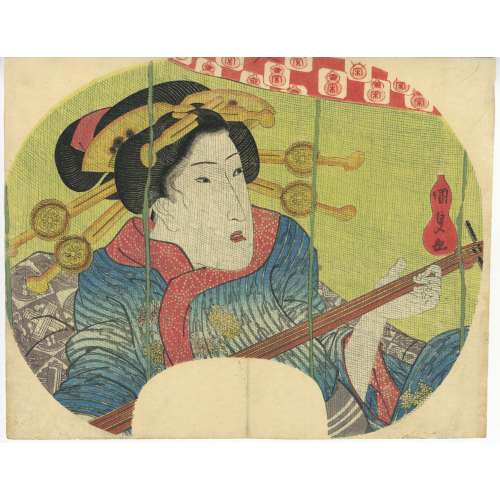 Artist: Utagawa Kunisada [歌川 国貞] a.k.a. Utagawa Toyokuni III [三代歌川豊国] (Japanese, 1786 – 1865). Signed: Kunisada ga [国貞画] in a red double-gourd cartouche Publisher: Unknown (no seal). Date: c. 1832 Izzard: "... red cloth decorated with the characters Yauan, one of Ichikawa Danjūrō VII [市川団十郎] (Japanese, 1791 – 1859) poetry names, and the name of his residence in Fukagawa. The absence of publisher's emblem and censorship seals may indicate that this was a privately issued print, not for public use". Ref.: [LIB-2967.2022] Utagawa Kunisada (1786 – 1865): His world revisited / Catalogue № 17, Exhibition March 17-21, 2021. — NY: Sebastian Izzard, LLC., 2021; p. 112-3, fig. 32). Size: Fan print (aiban uchiwa-e); 235 x 295 mm.
Artist: Utagawa Kunisada [歌川 国貞] a.k.a. Utagawa Toyokuni III [三代歌川豊国] (Japanese, 1786 – 1865). Signed: Kunisada ga [国貞画] in a red double-gourd cartouche Publisher: Unknown (no seal). Date: c. 1832 Izzard: "... red cloth decorated with the characters Yauan, one of Ichikawa Danjūrō VII [市川団十郎] (Japanese, 1791 – 1859) poetry names, and the name of his residence in Fukagawa. The absence of publisher's emblem and censorship seals may indicate that this was a privately issued print, not for public use". Ref.: [LIB-2967.2022] Utagawa Kunisada (1786 – 1865): His world revisited / Catalogue № 17, Exhibition March 17-21, 2021. — NY: Sebastian Izzard, LLC., 2021; p. 112-3, fig. 32). Size: Fan print (aiban uchiwa-e); 235 x 295 mm. -
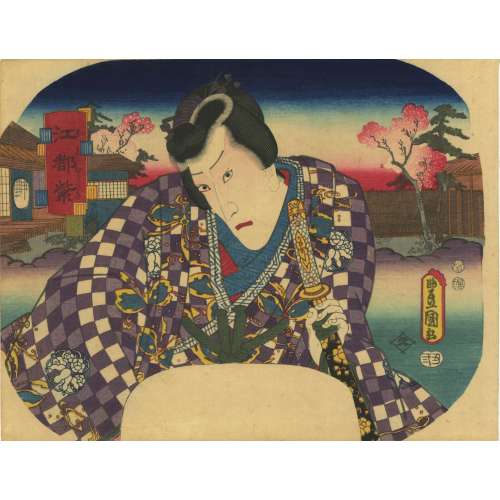 Utagawa Kunisada [歌川 国貞]; a.k.a. Utagawa Toyokuni III [三代歌川豊国] (Japanese, 1786 – 1865). Signed: Toyokuni ga [豊国 画] in a yellow toshidama cartouche. Publisher: Unknown, seal [久] Kyū (Japanese, fl. c. 1851 – 1861); (Marks 07-023 | U176a, possibly Sagamia Kyūzō). Date seal and double nanushi censor seals: Fuku & Muramatsu, Kaei 6, 2nd month (2/1853). Inscription in a red cartouche: (Purple of Edo // Purple of the Bay Capital) [江都むらさき] (Edo Murasaki), alluding to Murasaki Shikibu [紫 式部] (Japanese, c. 973/8 – c. 1014/31), the author of Genji Monogatari [源氏物語] (The Tale of Genji), a Heian period novel which was the source of a parody Nise Murasaki Inaka Genji [偐紫田舎源氏] (Fake Murasaki’s Rustic Genji) by Ryutei Tanehiko [柳亭種彦] (Japanese, 1783 – 1842). According to Horst Graebner: The actor is Ichikawa Danjūrō VIII. Ichikawa Danjūrō VIII [市川団十郎] (Japanese, 1823 – 1854); other names: Ichikawa Ebizō VI, Ichikawa Shinnosuke II. One of the series of Kunisada’s fan prints in this collection:
Utagawa Kunisada [歌川 国貞]; a.k.a. Utagawa Toyokuni III [三代歌川豊国] (Japanese, 1786 – 1865). Signed: Toyokuni ga [豊国 画] in a yellow toshidama cartouche. Publisher: Unknown, seal [久] Kyū (Japanese, fl. c. 1851 – 1861); (Marks 07-023 | U176a, possibly Sagamia Kyūzō). Date seal and double nanushi censor seals: Fuku & Muramatsu, Kaei 6, 2nd month (2/1853). Inscription in a red cartouche: (Purple of Edo // Purple of the Bay Capital) [江都むらさき] (Edo Murasaki), alluding to Murasaki Shikibu [紫 式部] (Japanese, c. 973/8 – c. 1014/31), the author of Genji Monogatari [源氏物語] (The Tale of Genji), a Heian period novel which was the source of a parody Nise Murasaki Inaka Genji [偐紫田舎源氏] (Fake Murasaki’s Rustic Genji) by Ryutei Tanehiko [柳亭種彦] (Japanese, 1783 – 1842). According to Horst Graebner: The actor is Ichikawa Danjūrō VIII. Ichikawa Danjūrō VIII [市川団十郎] (Japanese, 1823 – 1854); other names: Ichikawa Ebizō VI, Ichikawa Shinnosuke II. One of the series of Kunisada’s fan prints in this collection: -
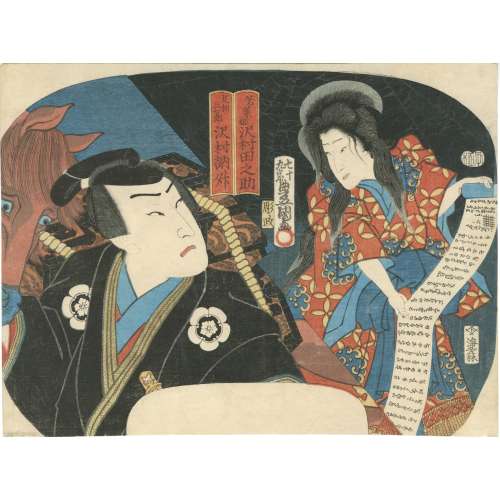 Artist: Utagawa Kunisada [歌川 国貞] a.k.a. Utagawa Toyokuni III [三代歌川豊国] (Japanese, 1786 – 1865). Artist signature: By the brush of the 79-year-old Toyokuni [七十九歳豊國画] (Nanajūkyū-sai Toyokuni ga). Publisher: Ebiya Rinnosuke [海老屋林之助] (Japanese, fl. c. 1832 – 1895); seal: ト/ 海老林 (to, Ebirin). Block carver: Matsushima Masakichi [松島政吉]; seal: carved by Masa [彫政] (Hori Masa). Combined date seal and kiwame censor seal: [子極] 1864 (Bunkyū 4/Genji 1). Media: Untrimmed fan print (uchiwa-e), 223 x 297 mm. Inscription in the cartouches: (R) Wakana-hime [若菜姫], Sawamura Tanosuke III [沢村田之助]; (L) Ashikaga Sanshichirō [足利三七郎], Sawamura Tosshō II [沢村訥升]. Play: Kinoene Soga Daikoku-bashira [甲子曽我大国柱], performed at the Morita theatre [森田座・守田座] (Morita-za) in 1864 (Bunkyū 4/Genji 1), 2nd month (see playbill at MFA-Boston Collection). Playwright: Muraoka Kōji II [村岡幸治]. Actors and Characters: Sawamura Tanosuke III [三代目沢村田之助] (Japanese, 1859 – 1878); other names: Shozan [曙山] (poetry name), Sawamura Yoshijirō I [初代沢村由次郎], here in the role of Princess Wakana [若菜姫] (Wakana-hime) (R). The story about Princess Wakana, Shiranui Monogatari, was written by Ryukatei Tanekazu [柳下亭種員] (Japanese, 1807 – 1858) and published as a 90-volume book of comics between 1849 and 1855. ...The tale revolves around the clash between the Kikuchi and Ōtomo clans. Princess Wakana’s father Ōtomo Sōrin [大友 宗麟] (1530 – 1587) was killed in a battle, and his spirit demanded revenge. To appease her late father's spirit, Princes Wakana acquired the power of the Earth Spider. She often appears in prints with a magic scroll, which helps her fight various enemies. Sawamura Tosshō II [二代目沢村訥升] (Japanese, 1854 – 1879); other names: Kōga [高賀] (poetry name), Sawamura Genpei II [二代目沢村源平], Sawamura Sōjūrō [澤村宗十郎], Suketakaya Takasuke IV [四代目助高屋高助], Sawamura Tosshi VI [六代目澤村訥子] (poetry name), here in the role of Ashikaga Sanshichirō [足利三七郎] (L) with a horse. According to Markus Sesko, the scene comes from the kabuki play Umakiri (馬斬り) by Tatsuoka Mansaku [辰岡万作] (17432 – 1809), which premiered in 1794. It was later assimilated into the Kabuki play Kozotte Mimasu Kuruwa no Datezome [襷廓三升伊達染], which was staged in the 1st lunar month of 1853 at the Nakamura-za. Umakiri is based on a Kyōgen play featured in Hideyoshi’s biography Taikōki [太閤記]. Its plot is that Ashikaga Sanchichirō Yoshitaka [足利三七郎義孝・義高], who is supposed to allude to Nobunaga’s son Oda Sanshichirō Nobutaka [織田三七郎信孝], attacks and kills a horse that is carrying 3,000 ryō (金三千両), money Mashiba Hisayoshi [真柴久吉] (an allusion to Hashiba Hideyoshi [羽柴秀吉]) had sent to be donated to a shrine on Mt. Kōya. The surrounding people try to catch him, but when they hear it is Yoshitaka who killed the horse, they fall to the ground and prostrate, and Yoshitaka leisurely leaves with the money. The plot is very simple, but Yoshitaka’s dashing appearance makes it very pleasing to watch. There are also prints that quote the main protagonist as Ashikaga Sanshichirō Harutaka [足利三七郎春高], and there is another title for the play, Sanzen-Ryō Kogane no Kurairi [三千両黄金蔵入] (Pocketing 3,000 ryō of gold). For reference, see also the BLOG. What these two characters are doing in one play remains a riddle. As Mr Graebner comments: "Most kabuki plays were only performed for one season (two months), and the books were lost. The playwrights have repeatedly used parts of plots from other plays, they have adopted characters, sometimes with the same or similar names. What can be found is the Kabuki Playbill (Tsuji banzuke) with cast and roles; the content is lost". Acknowledgements: Special thanks to Horst Graebner of the Kunisada Project and to Markus Sesko of The Metropolitan Museum, NY, for the analysis of the image and their invaluable contribution. For reference, see also:
Artist: Utagawa Kunisada [歌川 国貞] a.k.a. Utagawa Toyokuni III [三代歌川豊国] (Japanese, 1786 – 1865). Artist signature: By the brush of the 79-year-old Toyokuni [七十九歳豊國画] (Nanajūkyū-sai Toyokuni ga). Publisher: Ebiya Rinnosuke [海老屋林之助] (Japanese, fl. c. 1832 – 1895); seal: ト/ 海老林 (to, Ebirin). Block carver: Matsushima Masakichi [松島政吉]; seal: carved by Masa [彫政] (Hori Masa). Combined date seal and kiwame censor seal: [子極] 1864 (Bunkyū 4/Genji 1). Media: Untrimmed fan print (uchiwa-e), 223 x 297 mm. Inscription in the cartouches: (R) Wakana-hime [若菜姫], Sawamura Tanosuke III [沢村田之助]; (L) Ashikaga Sanshichirō [足利三七郎], Sawamura Tosshō II [沢村訥升]. Play: Kinoene Soga Daikoku-bashira [甲子曽我大国柱], performed at the Morita theatre [森田座・守田座] (Morita-za) in 1864 (Bunkyū 4/Genji 1), 2nd month (see playbill at MFA-Boston Collection). Playwright: Muraoka Kōji II [村岡幸治]. Actors and Characters: Sawamura Tanosuke III [三代目沢村田之助] (Japanese, 1859 – 1878); other names: Shozan [曙山] (poetry name), Sawamura Yoshijirō I [初代沢村由次郎], here in the role of Princess Wakana [若菜姫] (Wakana-hime) (R). The story about Princess Wakana, Shiranui Monogatari, was written by Ryukatei Tanekazu [柳下亭種員] (Japanese, 1807 – 1858) and published as a 90-volume book of comics between 1849 and 1855. ...The tale revolves around the clash between the Kikuchi and Ōtomo clans. Princess Wakana’s father Ōtomo Sōrin [大友 宗麟] (1530 – 1587) was killed in a battle, and his spirit demanded revenge. To appease her late father's spirit, Princes Wakana acquired the power of the Earth Spider. She often appears in prints with a magic scroll, which helps her fight various enemies. Sawamura Tosshō II [二代目沢村訥升] (Japanese, 1854 – 1879); other names: Kōga [高賀] (poetry name), Sawamura Genpei II [二代目沢村源平], Sawamura Sōjūrō [澤村宗十郎], Suketakaya Takasuke IV [四代目助高屋高助], Sawamura Tosshi VI [六代目澤村訥子] (poetry name), here in the role of Ashikaga Sanshichirō [足利三七郎] (L) with a horse. According to Markus Sesko, the scene comes from the kabuki play Umakiri (馬斬り) by Tatsuoka Mansaku [辰岡万作] (17432 – 1809), which premiered in 1794. It was later assimilated into the Kabuki play Kozotte Mimasu Kuruwa no Datezome [襷廓三升伊達染], which was staged in the 1st lunar month of 1853 at the Nakamura-za. Umakiri is based on a Kyōgen play featured in Hideyoshi’s biography Taikōki [太閤記]. Its plot is that Ashikaga Sanchichirō Yoshitaka [足利三七郎義孝・義高], who is supposed to allude to Nobunaga’s son Oda Sanshichirō Nobutaka [織田三七郎信孝], attacks and kills a horse that is carrying 3,000 ryō (金三千両), money Mashiba Hisayoshi [真柴久吉] (an allusion to Hashiba Hideyoshi [羽柴秀吉]) had sent to be donated to a shrine on Mt. Kōya. The surrounding people try to catch him, but when they hear it is Yoshitaka who killed the horse, they fall to the ground and prostrate, and Yoshitaka leisurely leaves with the money. The plot is very simple, but Yoshitaka’s dashing appearance makes it very pleasing to watch. There are also prints that quote the main protagonist as Ashikaga Sanshichirō Harutaka [足利三七郎春高], and there is another title for the play, Sanzen-Ryō Kogane no Kurairi [三千両黄金蔵入] (Pocketing 3,000 ryō of gold). For reference, see also the BLOG. What these two characters are doing in one play remains a riddle. As Mr Graebner comments: "Most kabuki plays were only performed for one season (two months), and the books were lost. The playwrights have repeatedly used parts of plots from other plays, they have adopted characters, sometimes with the same or similar names. What can be found is the Kabuki Playbill (Tsuji banzuke) with cast and roles; the content is lost". Acknowledgements: Special thanks to Horst Graebner of the Kunisada Project and to Markus Sesko of The Metropolitan Museum, NY, for the analysis of the image and their invaluable contribution. For reference, see also:



